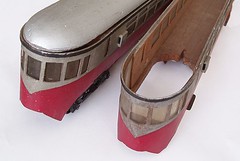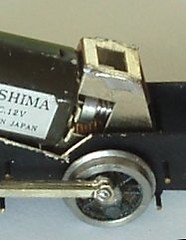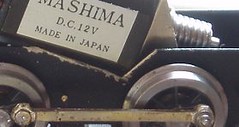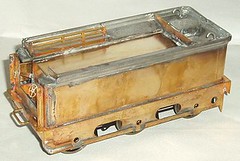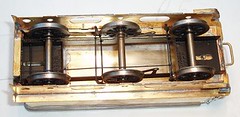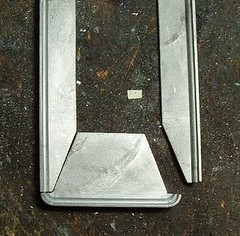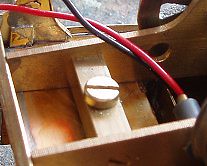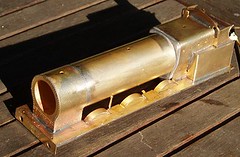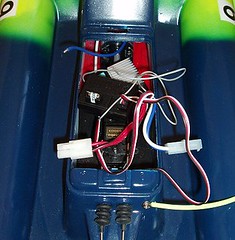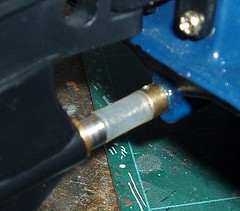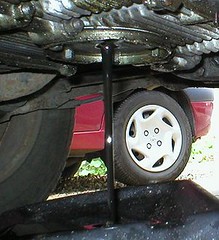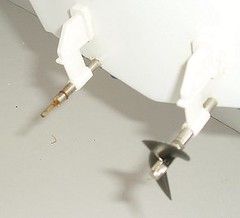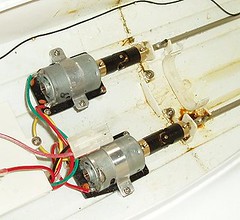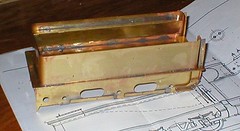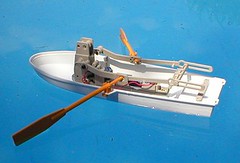Hooray – I’ve finally finished something !
The HO scale Barclay is complete. The simple livery (can something so plain be said to have a livery ?) doesn’t take long to complete. I sprayed the black and hand painted the red buffer beams. Fortunately an ex-works finish wasn’t required otherwise the paint “bloom” on the cab sides would have been a problem. As it is, the weathered finish is enhanced by the slightly washed out effect.
The WD and arrow had to be hand painted as I’ve never managed to find a transfer for this. I wish I could as this must be the fifth time I have built this loco (2 static plastic attempts before plans were available and 3 kits). Chris has a lot to answer for with Overlord.
Once I complete a loco it spends along while running up and down the test rack on the workbench. Not to run it in as a rolling road does this better, but just because I like to see the source of fun and frustration actually work. It'’ like watching telly but the plot and characters are better. Very relaxing.
A daily updated blog typed by someone with painty hands, oil under his fingernails and the smell of solder in his nostrils who likes making all sort of models and miniatures. And fixing things.
Sunday, July 30, 2006
Saturday, July 29, 2006
A hole lot of work
You should always build a working chassis before making the body. If you don’t you can find yourself spending a Friday night hacking your way through bits of a complete body in order to get the motor in.
I started with a slitting disk as far up the sides of the bulkhead as I could. Then I tried burs and grinders to do the rest. Nothing really worked so I used some tin snips to cut the metal up a bit. The leftovers were then twisted and waggled with small pliers to break them off. Not too bad in the case of the bulkhead at the end of the bonnet – the soldered joint gave way eventually allowing the mostly complete piece to be removed. The cab front gave more of a struggle it came as well.
A little soldering where the top of the bonnet had become loose, some filing on the sides to tidy the hole up – yes that is the tidy hole on the photo - and the motor went in. Good job the cab is so enclosed that you can’t see the back end of Mashima where the controls should be !
I started with a slitting disk as far up the sides of the bulkhead as I could. Then I tried burs and grinders to do the rest. Nothing really worked so I used some tin snips to cut the metal up a bit. The leftovers were then twisted and waggled with small pliers to break them off. Not too bad in the case of the bulkhead at the end of the bonnet – the soldered joint gave way eventually allowing the mostly complete piece to be removed. The cab front gave more of a struggle it came as well.
A little soldering where the top of the bonnet had become loose, some filing on the sides to tidy the hole up – yes that is the tidy hole on the photo - and the motor went in. Good job the cab is so enclosed that you can’t see the back end of Mashima where the controls should be !
LMS Railcar
Rooting around my local auction I was digging into a box of model railway tat and struck gold. Among the used Hornby buildings, broken O gauge Hornby and stuff there was this – a wooden OO model of an LMS 1930’s railcar.
Fortunately no one else showed any interest in the model although the second hand buildings in the lot had them looking and I was able to buy it for a price that should allow me to recoup my money from eBay.
The model fascinates me. It’s unfinished but is complete enough to appreciate the workmanship involved. As far as I know no kit was ever available for this prototype. The cleanness of the model making is astounding though. If the wooden sides weren’t die cut, how are the windows so square ? Curving the ends must also have been a challenge. I’m assuming the material was steamed otherwise it surly would have splintered.
Does anyone recognise this model ? Was it a kit ? If so, who produced it ?
I’ll still need to acquire bogies to finish the model – or cast some from the one currently attached.. Provision has been made for a motor bogie, which should by rights be a Tri-ang item. For the minute the model will be boxed up and put in the maturing cupboard. If I’m right it’s nearly 40 years old already so another few years won’t matter.
Fortunately no one else showed any interest in the model although the second hand buildings in the lot had them looking and I was able to buy it for a price that should allow me to recoup my money from eBay.
The model fascinates me. It’s unfinished but is complete enough to appreciate the workmanship involved. As far as I know no kit was ever available for this prototype. The cleanness of the model making is astounding though. If the wooden sides weren’t die cut, how are the windows so square ? Curving the ends must also have been a challenge. I’m assuming the material was steamed otherwise it surly would have splintered.
Does anyone recognise this model ? Was it a kit ? If so, who produced it ?
I’ll still need to acquire bogies to finish the model – or cast some from the one currently attached.. Provision has been made for a motor bogie, which should by rights be a Tri-ang item. For the minute the model will be boxed up and put in the maturing cupboard. If I’m right it’s nearly 40 years old already so another few years won’t matter.
Friday, July 28, 2006
Taller box
I have to confess that the last post to this blog was actually written a few days ago. Since then a quick ‘phone call has elicited the supply of a set of gears with the correct input shafts (1.5 not 2mm – it matters !) and a new taller gearbox.
The new box fitted fine once I’d removed the bit of paxolin intended to support the pick-ups. A word of advice here, if using Gibson wheels, check the axles. I managed to put the EM one in and start fitting the wheels before I noticed…
The cut outs in the chassis don’t need to be as big now but suprisingly they are still required. This motor is quite a chubby chap ! I still hope that under the footplate they don’t show up.
The rods and cranks were re-fitted and with a bit more fettling whirl round amazingly (for one of my chassis) smoothly. It was all a bit sticky before I oiled the axle with the cranks on though. A couple of drops and like magic, everything was fine. The effect was something I’ve never experienced, oil normally improves things but not instantly or as markedly.
One problem is that the motor now sits further back in the chassis. Which means it won’t go in the body because the cab front gets in the way. Grrrrrrrrrr.
The new box fitted fine once I’d removed the bit of paxolin intended to support the pick-ups. A word of advice here, if using Gibson wheels, check the axles. I managed to put the EM one in and start fitting the wheels before I noticed…
The cut outs in the chassis don’t need to be as big now but suprisingly they are still required. This motor is quite a chubby chap ! I still hope that under the footplate they don’t show up.
The rods and cranks were re-fitted and with a bit more fettling whirl round amazingly (for one of my chassis) smoothly. It was all a bit sticky before I oiled the axle with the cranks on though. A couple of drops and like magic, everything was fine. The effect was something I’ve never experienced, oil normally improves things but not instantly or as markedly.
One problem is that the motor now sits further back in the chassis. Which means it won’t go in the body because the cab front gets in the way. Grrrrrrrrrr.
Thursday, July 27, 2006
In HO, no one can hear you scream
Thanks to a cock-up in the supply of gearsets, I find myself fitting a tiny gearbox into the HO Barclay. The ‘box took a fair bit of fettling, much more than is normal with these things, but I made it work OK.
Then I had to fit it in the chassis and a problem appeared. The motor was too chubby for the frames. If I’d been working in P4 there wouldn’t have been a problem this is a 3.5mm loco. A taller gearbox would also solve the problem but there wasn’t one handy.
Out came the tin snips and with a little fiddling I think I made quite a nice job. The cut outs look worse than they are as with the motor painted black you won’t really see anything under the footplate.
With the motor & gears fitted the loco ran very sweetly. Putting the rods on cured this but only after a small amount of bad language and reaming out of holes even this problem was removed.
Then the gears lost mesh. I’d not managed to get them as tight as I should have done. The only solution is to remove the wheels, and gears to adjust or replace the box. I’m not happy.
Then I had to fit it in the chassis and a problem appeared. The motor was too chubby for the frames. If I’d been working in P4 there wouldn’t have been a problem this is a 3.5mm loco. A taller gearbox would also solve the problem but there wasn’t one handy.
Out came the tin snips and with a little fiddling I think I made quite a nice job. The cut outs look worse than they are as with the motor painted black you won’t really see anything under the footplate.
With the motor & gears fitted the loco ran very sweetly. Putting the rods on cured this but only after a small amount of bad language and reaming out of holes even this problem was removed.
Then the gears lost mesh. I’d not managed to get them as tight as I should have done. The only solution is to remove the wheels, and gears to adjust or replace the box. I’m not happy.
Monday, July 24, 2006
Etched brass tender
With most of the castings in place, the tender is looking pretty good. The work left involves superglue and not solder. I like this stage as it takes me back to sticking Airfix kits together.
Sunday, July 23, 2006
Underneath the tender
Fitting the chassis to the tender body was always going to be an interesting task. Unlike most models, the tender is going to be carrying the fuel – in this case the batteries. I need as much space as possible to fit these in, which means not much in the bottom to get in the way.
Of course I still need to fix the chassis in place. Normally I use bolts but only one was in with the kit for this task. Possibly a mix up in the packing but in this case it’s forced me to be inventive and come up with a “clever” solution.
One end is screwed in place conventionally. The other tucks into a pocket behind the buffer beam. As well as being quicker to assemble (I will probably have this chassis on and off a fair bit), it leaves the maximum amount of hole in the floor so I can squeeze those cells in place.
Of course I still need to fix the chassis in place. Normally I use bolts but only one was in with the kit for this task. Possibly a mix up in the packing but in this case it’s forced me to be inventive and come up with a “clever” solution.
One end is screwed in place conventionally. The other tucks into a pocket behind the buffer beam. As well as being quicker to assemble (I will probably have this chassis on and off a fair bit), it leaves the maximum amount of hole in the floor so I can squeeze those cells in place.
Flare Jigsaw
The tender flare for the G2 has been the cause of worry for me. I have two options: a set of whitemetal parts or a brass etched version.
The brass version looked promising except that the contact area between the top of the body and the brass flare would be tiny. This would make it weak. I’d also have to figure out how to do the rear corners.
This still looked better than the whitemetal version. I’ve looked at these parts for weeks and have struggled to work out how they work. The instructions are silent on the point, not mentioning the flare at all.
Of course my Dad picks the parts up and immediately sees what needs to happen. If you look at the photo it’s obvious – but I hadn’t spotted it for some reason. It cleverly includes the tender top – I’d been wondering why this wasn’t on the etch !
OK, the resulting part is too wide, but that was easy to fix but cutting and shutting. Low melt solder (still applied with a big iron) is a good filler and after some filing and sanding the result looks pretty good.
The brass version looked promising except that the contact area between the top of the body and the brass flare would be tiny. This would make it weak. I’d also have to figure out how to do the rear corners.
This still looked better than the whitemetal version. I’ve looked at these parts for weeks and have struggled to work out how they work. The instructions are silent on the point, not mentioning the flare at all.
Of course my Dad picks the parts up and immediately sees what needs to happen. If you look at the photo it’s obvious – but I hadn’t spotted it for some reason. It cleverly includes the tender top – I’d been wondering why this wasn’t on the etch !
OK, the resulting part is too wide, but that was easy to fix but cutting and shutting. Low melt solder (still applied with a big iron) is a good filler and after some filing and sanding the result looks pretty good.
Friday, July 21, 2006
Proper tools
When you are building high quality models, the mind automatically turns to thoughts of the toolkit commonly found in a jewellers workshop. Delicate little devices capable to assisting the finest of work.
Sometimes this kit isn’t enough though. For example I have always preferred a large file to a small one as it’s easier to file things flat as opposed to a series of small ridges. This was a trick suggested to me by a friend who had witnessed too many people messing around with needle files ‘cos that is what you are supposed to use. I now have three big files on the bench and the smallest is 8 inches long and half an inch wide. The needle files live in the packet most of the time.
Anyway, while fitting the chassis to the G2 I had to enlarge the holes in the spaces that take the bolts. This is a big loco so you use big bolts – simple really. Now the spacers are thick, solid brass and a needle files wouldn’t touch it. Neither would the tapered reamer.
So off to the garage to get the power drill. A Bosch rechargeable if you want to get anoraky about it. A few seconds work and I had a nice large hole in the spacer. Then I cleaned the edges with the countersink bit. Proper job.
Then the retaining nut wouldn’t fit under the footplate so there was the unedifying site of the loco being attacked with the drill as well. I’m sure this isn’t what those photos of proper “craftsmen” show.
It worked a treat though. Perhaps I should keep it within reach at all times. I wonder if a hammer drill would be useful too ?
Sometimes this kit isn’t enough though. For example I have always preferred a large file to a small one as it’s easier to file things flat as opposed to a series of small ridges. This was a trick suggested to me by a friend who had witnessed too many people messing around with needle files ‘cos that is what you are supposed to use. I now have three big files on the bench and the smallest is 8 inches long and half an inch wide. The needle files live in the packet most of the time.
Anyway, while fitting the chassis to the G2 I had to enlarge the holes in the spaces that take the bolts. This is a big loco so you use big bolts – simple really. Now the spacers are thick, solid brass and a needle files wouldn’t touch it. Neither would the tapered reamer.
So off to the garage to get the power drill. A Bosch rechargeable if you want to get anoraky about it. A few seconds work and I had a nice large hole in the spacer. Then I cleaned the edges with the countersink bit. Proper job.
Then the retaining nut wouldn’t fit under the footplate so there was the unedifying site of the loco being attacked with the drill as well. I’m sure this isn’t what those photos of proper “craftsmen” show.
It worked a treat though. Perhaps I should keep it within reach at all times. I wonder if a hammer drill would be useful too ?
Wednesday, July 19, 2006
Stop procrastinating
Got to get a move on with this or it will never get finished… Must tackle one of those jobs I keep putting off…
It’s brake gear time again. Since the bits are hidden behind the side frames of the tender they aren’t full of detail. Each hanger and shoe is a single etching – not a lot of depth but enough (for me) with the limited view you get. Besides, this loco is going to run on a garden railway where it will have to deal with slugs and snails on the rails. A friend describes how he had to remove the remains from the inside of a loco once – not pretty.
Once the brakes are on I quickly cleaned the metal, primed it and squeezed the can of matt black spray to get sufficient coverage.
The only change I made to the chassis before painting was to beef up the tops of the outer bearings. While a single thickness of metal should be OK, I have visions of carving a groove in the axle after a few miles of running. A bit of spare etch soldered in at the top should be enough.
Now all I have to do is fit it to the body. Some packing will be needed as the tender is a bit of a “low rider” at present. Nothing that a slice of plasticard won’t cure though.
It’s brake gear time again. Since the bits are hidden behind the side frames of the tender they aren’t full of detail. Each hanger and shoe is a single etching – not a lot of depth but enough (for me) with the limited view you get. Besides, this loco is going to run on a garden railway where it will have to deal with slugs and snails on the rails. A friend describes how he had to remove the remains from the inside of a loco once – not pretty.
Once the brakes are on I quickly cleaned the metal, primed it and squeezed the can of matt black spray to get sufficient coverage.
The only change I made to the chassis before painting was to beef up the tops of the outer bearings. While a single thickness of metal should be OK, I have visions of carving a groove in the axle after a few miles of running. A bit of spare etch soldered in at the top should be enough.
Now all I have to do is fit it to the body. Some packing will be needed as the tender is a bit of a “low rider” at present. Nothing that a slice of plasticard won’t cure though.
Saturday, July 15, 2006
Summer time and solder flows easy.
No retail therapy for me today. I decided I didn’t need anything in town that couldn’t be purchased online or in person during the week. This gives me an entire afternoon working on the G2.
Sometimes things just seem to go right. Today was one of those days. The kit parts fitted properly – OK I had to make new tank tops but everything else was fine. Solder generally went where it was supposed to. Maybe it was the heat which must be at least 27 degrees. Not too hot to do stuff outside but very pleasant sat in the shade with the windows open and Guildfest on the radio. It’s days like today I wish I could get into cricket as I’m sure some Radio 4 Long Wave commentary would be very condusive to my workmanship.
I had to put the first whitemetal part in, the massive firebox front casting. Ignoring all good advise I used the 40W iron that was giving good service for the rest of the kit. There wasn’t much chance of melting this beast !
The boiler is level after a slight trim of the smokebox saddle. Because this is such a plain loco I spent a fair bit of time confirming this before finally soldering everything in place. Get it wrong and no amount of work will improve the model.
So for 4 hours work I went from a footplate to something that looks like a steam engine. If I wasn’t going out tonight for beer I’d probably get most of the model built at this rate. Still, I must make my contribution to Gordon’s revenue must I ? Civic duty and all.
Sometimes things just seem to go right. Today was one of those days. The kit parts fitted properly – OK I had to make new tank tops but everything else was fine. Solder generally went where it was supposed to. Maybe it was the heat which must be at least 27 degrees. Not too hot to do stuff outside but very pleasant sat in the shade with the windows open and Guildfest on the radio. It’s days like today I wish I could get into cricket as I’m sure some Radio 4 Long Wave commentary would be very condusive to my workmanship.
I had to put the first whitemetal part in, the massive firebox front casting. Ignoring all good advise I used the 40W iron that was giving good service for the rest of the kit. There wasn’t much chance of melting this beast !
The boiler is level after a slight trim of the smokebox saddle. Because this is such a plain loco I spent a fair bit of time confirming this before finally soldering everything in place. Get it wrong and no amount of work will improve the model.
So for 4 hours work I went from a footplate to something that looks like a steam engine. If I wasn’t going out tonight for beer I’d probably get most of the model built at this rate. Still, I must make my contribution to Gordon’s revenue must I ? Civic duty and all.
Friday, July 14, 2006
How do you skin a Tomkat ?
Yet again the Tomkat is a bad moggie. Down at the waters edge everything checks out so I lift it onto the water.
And Nothing.
Back out on the table and more nothing. Steering yes, but no drive. Not even an attempt.
Back to the workbench and I poke around inside. As there is no drive I chase the electricity with a multimeter. It’s coming out of the speed control OK. If the motor isn’t plugged in it even comes out of the plug attached to the speed control. Put the motor on and there is nothing again.
So I try the motor on the end of the battery directly. It roars into life for about a second and then nothing. Repeated tries result in sparks at the battery but no life. From years of railway modelling I know this means a short circuit. Something metal has got in there or the motor has started to disintegrate.
But how do I get to motor out to check it ? As far as I can tell the drive system is assembled into the bottom of the boat and the top is heat-sealed in place. Taking screws out doesn’t seem to free anything. I can’t even get the ones out of the front of the motor thanks to the angle they are at. Even if I could the water jacket can’t be loose or it wouldn’t work which means dismantling the cooling system.
Is the motor removable ? Any suggestions ?
And Nothing.
Back out on the table and more nothing. Steering yes, but no drive. Not even an attempt.
Back to the workbench and I poke around inside. As there is no drive I chase the electricity with a multimeter. It’s coming out of the speed control OK. If the motor isn’t plugged in it even comes out of the plug attached to the speed control. Put the motor on and there is nothing again.
So I try the motor on the end of the battery directly. It roars into life for about a second and then nothing. Repeated tries result in sparks at the battery but no life. From years of railway modelling I know this means a short circuit. Something metal has got in there or the motor has started to disintegrate.
But how do I get to motor out to check it ? As far as I can tell the drive system is assembled into the bottom of the boat and the top is heat-sealed in place. Taking screws out doesn’t seem to free anything. I can’t even get the ones out of the front of the motor thanks to the angle they are at. Even if I could the water jacket can’t be loose or it wouldn’t work which means dismantling the cooling system.
Is the motor removable ? Any suggestions ?
Wednesday, July 12, 2006
Flippin' Freeview
Here’s a job that has been kicking around for a while. I have a Freeview box – great you would think - digital telly with all the exciting channels that brings with it. Trouble is that the top of the TV slopes and so I can’t sit the box on top of it. Apparently you can’t just stick a big nail through the top of both. Something to do with the electrics.
The box can’t go on a separate stand either as there isn’t one. The only place is on the shelf about the TV. But I want to put stuff on there and I don’t mean my lifetime subscription to “TV Quick” magazine !
The solution was obvious. Fix the box underneath the shelf. Knock up some brackets and fix it in position. Easy for anyone with a modicum of skill and a fine selection of tools. I’ve got the tools…
The brackets came from Focus and were bent with the aid of a big vice (stop sniggering out there, the sort you attach to a workbench) and a medium sized hammer. Bend the bracket into a sort of Z shape (look at the photo to see what I mean) and for real finesse, add a couple of soft pads where it will touch the box.
Two brackets were enough, as they just had to push the rubber feet on the box against the shelf. I didn't realise how wonky they were until I looked at the photo. You can't see it form normal angles so I'll leave well alone.All the cables were stuffed in the back and it works well. Apart from the writing on the front being upside down you wouldn’t be able to tell that the device wasn’t meant to be that way.
All done in time for me to catch the final Dr Who of the series. All I needed was an incentive…
The box can’t go on a separate stand either as there isn’t one. The only place is on the shelf about the TV. But I want to put stuff on there and I don’t mean my lifetime subscription to “TV Quick” magazine !
The solution was obvious. Fix the box underneath the shelf. Knock up some brackets and fix it in position. Easy for anyone with a modicum of skill and a fine selection of tools. I’ve got the tools…
The brackets came from Focus and were bent with the aid of a big vice (stop sniggering out there, the sort you attach to a workbench) and a medium sized hammer. Bend the bracket into a sort of Z shape (look at the photo to see what I mean) and for real finesse, add a couple of soft pads where it will touch the box.
Two brackets were enough, as they just had to push the rubber feet on the box against the shelf. I didn't realise how wonky they were until I looked at the photo. You can't see it form normal angles so I'll leave well alone.All the cables were stuffed in the back and it works well. Apart from the writing on the front being upside down you wouldn’t be able to tell that the device wasn’t meant to be that way.
All done in time for me to catch the final Dr Who of the series. All I needed was an incentive…
Tuesday, July 11, 2006
Drive re-connected
The drive shaft fits. Like a good boy I greased it in an effort to repel rust. Carefully fitted it to the boat and then gingerly tested it out of the water.
Nothing. We have steering but no drive. I slacken things off and still nothing. Time for plenty of muttering and poking around in the mechanicals.
Suddenly there is life. A loose connection was the problem. The motor roars and I realise I need to tighten things up again.
I hope this holds. Apparently Ripmax don’t stock this part as a spare. The one Maxx Models got me was a one-off and might not be repeated. Ripmax don’t have an e-mail address either on their site so I don’t hold out much hope. With 5 broken shafts among the clubs boats, the racing might be a bit limited this Sunday.
Nothing. We have steering but no drive. I slacken things off and still nothing. Time for plenty of muttering and poking around in the mechanicals.
Suddenly there is life. A loose connection was the problem. The motor roars and I realise I need to tighten things up again.
I hope this holds. Apparently Ripmax don’t stock this part as a spare. The one Maxx Models got me was a one-off and might not be repeated. Ripmax don’t have an e-mail address either on their site so I don’t hold out much hope. With 5 broken shafts among the clubs boats, the racing might be a bit limited this Sunday.
Monday, July 10, 2006
Tape repair
I’ve never repaired a tape before. To be honest, it’s not something I’ll ever make a living out of what with the rise of the CD and all. Still, sometimes you get to try these things.
The demise of the audio cassette has resulted in a lot of people selling them off. Most are rubbish compilation albums but amongst the dross you can find gems. I’ve now nearly completed my collection of “I’m sorry I haven’t a clue” at bargain prices on eBay.
Out of all the tapes I managed to get a single duff one. Obviously rewound far to fast, the tape had broken off from the reel. Not soemthing you spot until it goes back in the player and doesn’t work.
Fortunately in the back of the cupboard holding “things that will come in handy one day”, I had a tape splicing and repair kit. It’s meant to allow you to edit tapes by splicing them together. When I worked for a hospital radio station I fancied having a crack at this. Of course this has now gone the way of the tape as all editing is carried out digitally.
Still I had my kit and once the front and back of the cassette were separate by sliding a sharpish scalpel down the join the tape was re-attached to the reel with the bright yellow sticky tape provided. A little rethreading and touch of glue to put the cassette back together and the tape was as good as new.
It took less time to do than to write and was good fun. I don’t feel half as guilty about the junk in the cupboard. Who knows what I’ll be able to fix next time ?
The tape was very funny too !
The demise of the audio cassette has resulted in a lot of people selling them off. Most are rubbish compilation albums but amongst the dross you can find gems. I’ve now nearly completed my collection of “I’m sorry I haven’t a clue” at bargain prices on eBay.
Out of all the tapes I managed to get a single duff one. Obviously rewound far to fast, the tape had broken off from the reel. Not soemthing you spot until it goes back in the player and doesn’t work.
Fortunately in the back of the cupboard holding “things that will come in handy one day”, I had a tape splicing and repair kit. It’s meant to allow you to edit tapes by splicing them together. When I worked for a hospital radio station I fancied having a crack at this. Of course this has now gone the way of the tape as all editing is carried out digitally.
Still I had my kit and once the front and back of the cassette were separate by sliding a sharpish scalpel down the join the tape was re-attached to the reel with the bright yellow sticky tape provided. A little rethreading and touch of glue to put the cassette back together and the tape was as good as new.
It took less time to do than to write and was good fun. I don’t feel half as guilty about the junk in the cupboard. Who knows what I’ll be able to fix next time ?
The tape was very funny too !
Sunday, July 09, 2006
Oils well that ends well
Changing oil on an air-cooled Volkswagen is a pretty easy and normally pleasant activity. For relatively little effort you have the glow of satisfaction from a job well done. All the books say regular oil changes are a must so it has to be doing your car some good.
If you want to look after your engine, oil change intervals should be ignored. The true VeeDubber will replace the oil as soon as it starts to become dirty. That way you aren’t sloshing muck around your engine.
My recent issues with the camper have meant that I ignored this sensible advice and my oil was black and horrible. Time to drop it into the can for the recycling centre and put some nice stuff it.
A 21mm socket removes the big drain plug (if you don’t have one of these, change the sump plate when you next change your oil) and after a couple of hours the engine should be empty. Most of it is out after 5 minutes but it’s an excuse to leave the job while pretending it’s being done properly.
The sump plate is unbolted (10mm nuts) and the oil strainer is removed. Everything is cleaned up with white spirit and the muck left over goes into the recycling can. This is the only point things can go wrong – metal shavings on the plate can mean trouble.
Using a 50p change kit consisting of two card gaskets and some cheap washers, reassembly is simple but don’t go mad tightening the nuts in case they pull the studs out of the engine. Then tip oil in the top (2.5 litres) until it makes the middle of the mark on the dipstick. You need to check this after an hour or so as the oil takes a while to seep through the engine to the stick.
Clean up and feel that warm glow of success.
If you want to look after your engine, oil change intervals should be ignored. The true VeeDubber will replace the oil as soon as it starts to become dirty. That way you aren’t sloshing muck around your engine.
My recent issues with the camper have meant that I ignored this sensible advice and my oil was black and horrible. Time to drop it into the can for the recycling centre and put some nice stuff it.
A 21mm socket removes the big drain plug (if you don’t have one of these, change the sump plate when you next change your oil) and after a couple of hours the engine should be empty. Most of it is out after 5 minutes but it’s an excuse to leave the job while pretending it’s being done properly.
The sump plate is unbolted (10mm nuts) and the oil strainer is removed. Everything is cleaned up with white spirit and the muck left over goes into the recycling can. This is the only point things can go wrong – metal shavings on the plate can mean trouble.
Using a 50p change kit consisting of two card gaskets and some cheap washers, reassembly is simple but don’t go mad tightening the nuts in case they pull the studs out of the engine. Then tip oil in the top (2.5 litres) until it makes the middle of the mark on the dipstick. You need to check this after an hour or so as the oil takes a while to seep through the engine to the stick.
Clean up and feel that warm glow of success.
Friday, July 07, 2006
Going round in circles
With battery fully charged, the white speedboat hit the water. It raced off towards the buoys in a reasonably straight line. After a bit of racing around – with the battery giving am impressive length of run – things seemed to be pretty good. Perhaps the lubrication on the shafts was smearing itself around a bit but the running seemed to improve over time. Hoping around the lake, including over several buoys and being shoved off the bank a couple of times – it’s a fast boat after all – things were looking good. This is a very impressive boat on the water.
Then it all went wrong. The motor noise changed and the boat starting going around in tight circles. We assumed one of the shafts had worked lose but had to wait until the light wind blew it into the side (can’t steer a bot like this with only one motor working !). A propeller was missing !
The retaining nut had obviously worked lose and spin off. This and the prop are now at the bottom of the lake. Good job we have spares from the spares boat. A little superglue will be helping the grip next time we sail I think.
Then it all went wrong. The motor noise changed and the boat starting going around in tight circles. We assumed one of the shafts had worked lose but had to wait until the light wind blew it into the side (can’t steer a bot like this with only one motor working !). A propeller was missing !
The retaining nut had obviously worked lose and spin off. This and the prop are now at the bottom of the lake. Good job we have spares from the spares boat. A little superglue will be helping the grip next time we sail I think.
Thursday, July 06, 2006
Will this save my Tomkat ?
Thanks to the guys at Maxx Models I now have a replacement drive shaft for the TomKat.
28mm long, 2.6mm wide.
I just hope it gets me back on the water !
28mm long, 2.6mm wide.
I just hope it gets me back on the water !
Wednesday, July 05, 2006
Victory - At a very fast speed !
Last year we bought a RTR model boat. A fine looking speedboat. Just to get starting with this sailing lark while the “proper” boats were being built you understand. The model featured laughably translated text on the box and instructions but it looked good and when first placed on the water, ran well.
A couple of minutes into a run though it pulled to the left very badly. Charging, oiling and tightening didn’t help so it was relegated to the shelf.
While browsing in the local model shop I mentioned this and they said that someone else had had the same problem. A few minutes later I was the owner of another boat sans transmitter and battery but otherwise the same. It had been destined for the dustbin so I got it for free.
The possible causes of the problem were a loose coupling between the motor & drive shaft or a duff motor. Not wanting to go at this half-cocked the couplings (a weird mix of plastic tubes, aluminium ends and lots of grease) have been replaced with proper UJ’s and the suspect motor has gone and one from the spare boat is in its place. The joints were off the shelf although I had to ream out the shaft end as the RTR shafts are slightly non-standard in size.
This is one boat that can’t be tested in the pool. I tired by holding it in place and I think it looks OK but the battery went flat before I could be sure. This goes on charge tonight for a test tomorrow.
A couple of minutes into a run though it pulled to the left very badly. Charging, oiling and tightening didn’t help so it was relegated to the shelf.
While browsing in the local model shop I mentioned this and they said that someone else had had the same problem. A few minutes later I was the owner of another boat sans transmitter and battery but otherwise the same. It had been destined for the dustbin so I got it for free.
The possible causes of the problem were a loose coupling between the motor & drive shaft or a duff motor. Not wanting to go at this half-cocked the couplings (a weird mix of plastic tubes, aluminium ends and lots of grease) have been replaced with proper UJ’s and the suspect motor has gone and one from the spare boat is in its place. The joints were off the shelf although I had to ream out the shaft end as the RTR shafts are slightly non-standard in size.
This is one boat that can’t be tested in the pool. I tired by holding it in place and I think it looks OK but the battery went flat before I could be sure. This goes on charge tonight for a test tomorrow.
Sunday, July 02, 2006
G2 Tender
After a bit of break in the work on the G2 I fancied starting on the tender instead of carrying on with the loco. The tender will be a bit special on this model – it will hold the fuel for the model. By this I mean there will be a chunk of battery in there.
So, I ploughed ahead. There are a few interesting features of the kit. The footplate for the tender appears to be etched back to front. A problem but not insurmountable. Far more of an issue is the big lumps of brass required. I used a miniature blowtorch to run solder around, as even my (40W) iron wasn’t man enough for the job.
The difficult bends in the sides (the wrapper is a single etched part) were achieved with reasonable ease. Fold up strengtheners are included so ignore the instructions I put the back bends in first, solder these in and the made the front bends.
After only a little fiddling with fingers and re-bending the job was complete. So far it looks good and my square says all is well. Long term my plan is to cut out as much of the floor as possible. The battery will fix to a false roof with velcro and then the chassis will bolt on the bottom to give extra security. I still have to fit a charging socket and speed switch so I’m not out of the woods yet.
So, I ploughed ahead. There are a few interesting features of the kit. The footplate for the tender appears to be etched back to front. A problem but not insurmountable. Far more of an issue is the big lumps of brass required. I used a miniature blowtorch to run solder around, as even my (40W) iron wasn’t man enough for the job.
The difficult bends in the sides (the wrapper is a single etched part) were achieved with reasonable ease. Fold up strengtheners are included so ignore the instructions I put the back bends in first, solder these in and the made the front bends.
After only a little fiddling with fingers and re-bending the job was complete. So far it looks good and my square says all is well. Long term my plan is to cut out as much of the floor as possible. The battery will fix to a false roof with velcro and then the chassis will bolt on the bottom to give extra security. I still have to fit a charging socket and speed switch so I’m not out of the woods yet.
Saturday, July 01, 2006
Robot Rower
Isn’t eBay dangerous ? Some light browsing ends up with the purchase of all sorts of unnecessary junk.
Not that this applies to my latest purchase, a “Rowboat kit” from Tamiya. 6 quid including postage.
What posses the Japanese producer of plastic kits to knock this sort of thing out ? Tooling up must cost a fortune and yet the sales are never going to be huge. Serious work has gone into making this a joy to build – no soldering or glueing just screw together assembly. The gearbox is neat and includes a hexagonal rod for the drive to the “shoulders” which must ramp the costs up on its own. A small tube of grease is included for the gears and some polystyrene sits at the back for extra floatation, or at least to protect against sinking.
On a hot afternoon this was fun to assemble. Half an hours leisurely work and then off to the pool for playtime. The little robot paddles across the water at quite a speed. His rowing action really is good. When he traverses the boating lake he’ll give plenty of people a good laugh.
Not that this applies to my latest purchase, a “Rowboat kit” from Tamiya. 6 quid including postage.
What posses the Japanese producer of plastic kits to knock this sort of thing out ? Tooling up must cost a fortune and yet the sales are never going to be huge. Serious work has gone into making this a joy to build – no soldering or glueing just screw together assembly. The gearbox is neat and includes a hexagonal rod for the drive to the “shoulders” which must ramp the costs up on its own. A small tube of grease is included for the gears and some polystyrene sits at the back for extra floatation, or at least to protect against sinking.
On a hot afternoon this was fun to assemble. Half an hours leisurely work and then off to the pool for playtime. The little robot paddles across the water at quite a speed. His rowing action really is good. When he traverses the boating lake he’ll give plenty of people a good laugh.
Subscribe to:
Comments (Atom)


